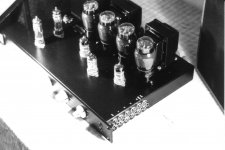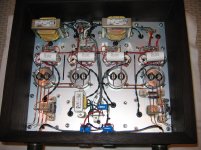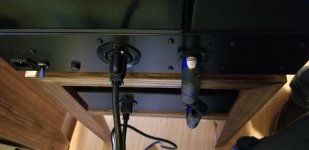The question here is how to divide up an amplifier that would be too heavy on one chassis.
1. Monobloks. Looks nice, compact, good rectifier choices, but duplicates the mains transformer and chokes.
2. Separate filament supplies. Very useful for DC choke input supplies to DHTs like 300b, 2a3, 26, 10Y, 01A etc. The transformers and chokes can be big if filament bias is used e.g. on 26 or 10Y, and the transformer voltage varies with the operating point. This solution offers flexibility and keeps chokes away from the main chassis
3. Separate PSU. This way you put a good chunk of the weight - mains transformer and first choke - on a separate chassis dividing the total weight neatly. Downside is the heater supplies can be in the mains transformer, so AC leads etc.... or convert to DC....
4. All heater/filament supplies on main chassis (unless chokes are a problem with DHTs). Separate PSU chassis for just the HT. Allows all the valves to be heated before the HT is switched on.
5. Other?
What format do you like to follow when the amplifier is too heavy on one chassis?
1. Monobloks. Looks nice, compact, good rectifier choices, but duplicates the mains transformer and chokes.
2. Separate filament supplies. Very useful for DC choke input supplies to DHTs like 300b, 2a3, 26, 10Y, 01A etc. The transformers and chokes can be big if filament bias is used e.g. on 26 or 10Y, and the transformer voltage varies with the operating point. This solution offers flexibility and keeps chokes away from the main chassis
3. Separate PSU. This way you put a good chunk of the weight - mains transformer and first choke - on a separate chassis dividing the total weight neatly. Downside is the heater supplies can be in the mains transformer, so AC leads etc.... or convert to DC....
4. All heater/filament supplies on main chassis (unless chokes are a problem with DHTs). Separate PSU chassis for just the HT. Allows all the valves to be heated before the HT is switched on.
5. Other?
What format do you like to follow when the amplifier is too heavy on one chassis?
My clear favorite:
Monoblocks! 😀
If an amp gets uncomfortably heavy, it often implies high power.
Although building monoblocks means you need twice as many power transformers and chokes, each need to supply only half the power. Therefore they can be smaller and slightly cheaper.
I also like the aesthetics of two similar chassis (symmetry?).
Separating power supplies from the amp chassis for high power amps is not something I am too fond off (chords and connectors carrying maybe 500 Volts or more). I also would not want to run heater supplies through such a chord and connector.
Of course it is not impossible. There are high voltage/high current cables and connectors, that are also safe (no open pins), but they tend to be very expensive and can be quite large.
For low power preamps, I feel differently. But that was not your question.
As usual, YMMV. Just my 2ct worth.
Cheers,
Martin
Monoblocks! 😀
If an amp gets uncomfortably heavy, it often implies high power.
Although building monoblocks means you need twice as many power transformers and chokes, each need to supply only half the power. Therefore they can be smaller and slightly cheaper.
I also like the aesthetics of two similar chassis (symmetry?).
Separating power supplies from the amp chassis for high power amps is not something I am too fond off (chords and connectors carrying maybe 500 Volts or more). I also would not want to run heater supplies through such a chord and connector.
Of course it is not impossible. There are high voltage/high current cables and connectors, that are also safe (no open pins), but they tend to be very expensive and can be quite large.
For low power preamps, I feel differently. But that was not your question.
As usual, YMMV. Just my 2ct worth.
Cheers,
Martin
My personal problem with monoblocks is the need for a preamp (or the inconvenience of having two separate volume and maybe also input controls).
I don't like preamps, be they active or passive. I see them as totally unnecessary and therefore pointless entities (except for RIAA stages and such, but those aren't "preamps" in the broad sense). I like my amps integrated, at least for the line level signals.
Separating the PSU and the amp itself poses some technical challenges indeed, but at least it makes sense.
I don't like preamps, be they active or passive. I see them as totally unnecessary and therefore pointless entities (except for RIAA stages and such, but those aren't "preamps" in the broad sense). I like my amps integrated, at least for the line level signals.
Separating the PSU and the amp itself poses some technical challenges indeed, but at least it makes sense.
This is an interesting question, probably one we have all thought about, and in the end it is a personal choice. I do as you say in number 4. I have come to this after years of building monoblocks. I purchase the highest quality transformers and chokes I can find on auction when they show up ridiculously cheap, and stash them for a new project. The power transformers and chokes go on their own chassis with a single umbilical for the B+. All the heater and filament transformers go on the amplifier chassis so they are near their respective tubes. Both the power supply chassis and the amplifier chassis (heaters) have their own power switch making it easy to turn on the heaters first. As the heaters warm up, I turn on the lights in the room, and then the power transformer.
Choice #1
I like monoblocks. If one fails, you still have the other to listen to. Yes, I am fine with listening to one amp for the time being and still better than no amp or music at all. It's also easier to troubleshoot when one fails so you can cross reference each other to find the culprit component(s). They can also be placed close to the speakers. And they look good!
I am not a purist so a line preamp is an essential part of the enjoyment to flavor the sound. I have no interest in the masochistic theoretical ideal of "straight wire with gain." Yes, I like a judicial touch of coloration. If possible, I even want a compressor and EQ in line to tweak the sound, if noise is not an issue.
I like monoblocks. If one fails, you still have the other to listen to. Yes, I am fine with listening to one amp for the time being and still better than no amp or music at all. It's also easier to troubleshoot when one fails so you can cross reference each other to find the culprit component(s). They can also be placed close to the speakers. And they look good!
I am not a purist so a line preamp is an essential part of the enjoyment to flavor the sound. I have no interest in the masochistic theoretical ideal of "straight wire with gain." Yes, I like a judicial touch of coloration. If possible, I even want a compressor and EQ in line to tweak the sound, if noise is not an issue.
Option 5. Other
I'm taking this as a form factor question, so disregarding all the electronic benefits/challenges of PSU separated Monoblock's.
I like Vinyl Savors approach of going up instead of out on the footprint. The PSU can be built into a "brick" that has the same footprint (width/depth) as the amp. Then the amp can sit neatly right on top of the "brick", with a short umbilical and aircraft connector. Looking like a regular, but taller, amp. Or you make a longer umbilical where the brick sits on the floor and amp on shelves. Rectifier tubes can be inside the brick with ventilation and a slow fan, ruggedized. In the Vinyl Savor designs you'll see the PSU in the "basement" of the vertical case, the amp tubes on the "roof" and OPT's on the middle floor. Vinyl Savor is kind of like a separate PSU without the separate chassis I guess. They are gorgeous amps by the way.
I'm taking this as a form factor question, so disregarding all the electronic benefits/challenges of PSU separated Monoblock's.
I like Vinyl Savors approach of going up instead of out on the footprint. The PSU can be built into a "brick" that has the same footprint (width/depth) as the amp. Then the amp can sit neatly right on top of the "brick", with a short umbilical and aircraft connector. Looking like a regular, but taller, amp. Or you make a longer umbilical where the brick sits on the floor and amp on shelves. Rectifier tubes can be inside the brick with ventilation and a slow fan, ruggedized. In the Vinyl Savor designs you'll see the PSU in the "basement" of the vertical case, the amp tubes on the "roof" and OPT's on the middle floor. Vinyl Savor is kind of like a separate PSU without the separate chassis I guess. They are gorgeous amps by the way.
Last edited:
I prefer the 3-chassis approach.
First chassis consists of dual completely independent power supplies. Two power transformers, two chokes, two capacitors. Into the left umbilical goes first DC B+ circuit, and one 105VAC circuit for heat. Into the right umbilical goes second DC B+ circuit, and another 105VAC circuit for heat.
I say 105V instead of 120V, since I purposefully run my heating transformers at reduced excitation for control of radiated fields. Separate switch to allow heaters to turn on prior to B+ is an option, but I use damper diodes for my B+ so it's not much of a concern.
Left amplifier chassis has additional capacitance for B+ filtering. Same for right chassis.
Left amplifier chassis has a corner dedicated to heater transformers/chokes as required for the application. Provide as much separation as possible. Depending on tubes used, either straight AC heating or DC heating. Coleman regulators, if used, as close to the tube as possible.
Same for right chassis.
Left/right chassis located reasonably close to speakers. Those amplifiers have a very low 60/120 Hz footprint as a result. If the power chassis wants to exhibit a bit of magnetic radiation, let it.
Umbilicals are not a great challenge; good quality multiple shielded twisted pair is easy to source, and amphenol or CPC connectors are off-the-shelf.
First chassis consists of dual completely independent power supplies. Two power transformers, two chokes, two capacitors. Into the left umbilical goes first DC B+ circuit, and one 105VAC circuit for heat. Into the right umbilical goes second DC B+ circuit, and another 105VAC circuit for heat.
I say 105V instead of 120V, since I purposefully run my heating transformers at reduced excitation for control of radiated fields. Separate switch to allow heaters to turn on prior to B+ is an option, but I use damper diodes for my B+ so it's not much of a concern.
Left amplifier chassis has additional capacitance for B+ filtering. Same for right chassis.
Left amplifier chassis has a corner dedicated to heater transformers/chokes as required for the application. Provide as much separation as possible. Depending on tubes used, either straight AC heating or DC heating. Coleman regulators, if used, as close to the tube as possible.
Same for right chassis.
Left/right chassis located reasonably close to speakers. Those amplifiers have a very low 60/120 Hz footprint as a result. If the power chassis wants to exhibit a bit of magnetic radiation, let it.
Umbilicals are not a great challenge; good quality multiple shielded twisted pair is easy to source, and amphenol or CPC connectors are off-the-shelf.
I followed ReinoutdV's example (just a lot smaller than his 833/TB3-1000): mono's with their own separate power supply chassis.
Even so, the PSUs are still backbreakers.
Even so, the PSUs are still backbreakers.
...Vinyl Savors approach of going up instead of out on the footprint...
Yes, this is very nice!
Best of both worlds if done in monoblocks.
And also a nice way to make amps that stick out of the crowd.
I would like to try this for a headphone amp in the future. Power supply close to the floor, amp at a convenient hight. Small footprint.
Definitely thumbs up from me!
Cheers,
Martin
I'm with TG with this one, all in one case but fully separated power supply's for each channel giving the best sound to my ears...
My first tube amp 6V6PP was like that... all line level inputs - just like Audio Innovations 700 I believe... but lower power of course🙂
My first tube amp 6V6PP was like that... all line level inputs - just like Audio Innovations 700 I believe... but lower power of course🙂
Attachments
Member
Joined 2009
Paid Member
1. keep amps close to their speakers and keep psu’s close to their power amps. Keep current loops tight, high voltages inside earthed boxes.
6. go mono. I’m a big fan of single speaker mono.
6. go mono. I’m a big fan of single speaker mono.
I followed ReinoutdV's example (just a lot smaller than his 833/TB3-1000): mono's with their own separate power supply chassis.
Even so, the PSUs are still backbreakers.
No doubt - this is just the power supply. Left output B+, left input/driver C+, right output B+, right input/driver C+. No way you could squeeze this all on one chassis and still fit it in a rack, much less lift it. If I recall, this power supply was in the neighborhood of 75 lbs.
Really depends on the size/complexity of the build. A flea amp is no challenge for physical build.
Attachments
Well, I went the monoblock all-in-one-box route with my Midlife Crisis 833C amps with excellent results for 7 years. 300uV background noise at idle with input shorted, faint buzz if you put your head to the midrange driver. Almost too heavy for two men to carry to my workroom. Dangerously heavy.
Now I'm pulling the 833C filament and 6E5P DC heater supplies into separate boxes, which should save 15lbs or so and allow me to double the amperage rating of the first choke in the LCLC filament supply. One side done and now the amp is absolutely dead silent with ear to the driver and somewhat easier for two men to carry.
Using 4-pole right-angle speakons to connect the boxes, plus a standard IEC power cord.
Now I'm pulling the 833C filament and 6E5P DC heater supplies into separate boxes, which should save 15lbs or so and allow me to double the amperage rating of the first choke in the LCLC filament supply. One side done and now the amp is absolutely dead silent with ear to the driver and somewhat easier for two men to carry.
Using 4-pole right-angle speakons to connect the boxes, plus a standard IEC power cord.
Attachments
- Home
- Amplifiers
- Tubes / Valves
- Monobloks, separate PSU, separate filament supply...?




